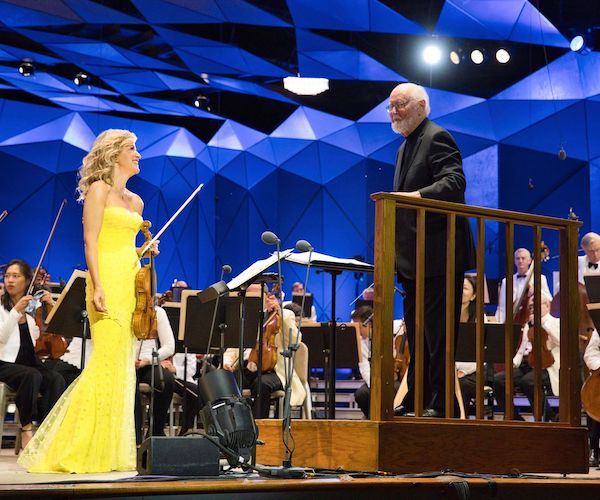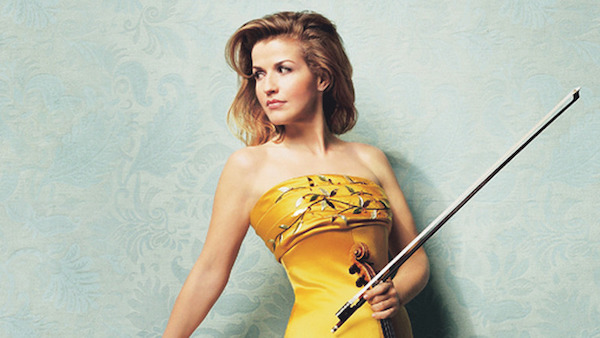Concert Preview/Interview: Anne-Sophie Mutter Plays John Williams’s Violin Concerto no. 2
By Jonathan Blumhofer
A packed, wide-ranging conversation with violinist Anne-Sophie Mutter that touches on several subjects, from a lifelong love of jazz to her verdict on John Williams’s Violin Concerto no. 2.

John Williams and Anne-Sophie Mutter perform his Violin Concerto No. 2 with BSO, Dress Rehearsal. Photo: Hilary Scott
“The writing is amazing — it’s highly poetic. There’s this combination of intellect, thought, and execution in it that I think is very inviting.” Such is violinist Anne-Sophie Mutter’s verdict on John Williams’s Violin Concerto no. 2. The latest in a string of commissions from the German violinist, the Concerto received its premiere in July at Tanglewood, with Mutter as soloist and the composer conducting the Boston Symphony Orchestra (BSO). (Arts Fuse review)
This weekend, Mutter, Williams, and the Concerto are the centerpiece of the BSO’s season-opening concerts at Symphony Hall (which are also the ensemble’s first performances before live audiences in Boston since March 2020).
I caught up with Mutter on Monday morning by phone from her hotel in Boston. She is as thoughtful, articulate, and forthright in conversation as she is when performing onstage, and ours was a packed, wide-ranging conversation that touched on several subjects (including a lifelong love of jazz). Below is a condensed and edited transcript of the discussion.
Art Fuse: To start, I thought we could talk a little bit about some of the pieces you’ve commissioned in the past. The composers who have written for you are a who’s-who of late-20th-/early-21st-century music: Witold Lutoslawski, Wolfgang Rihm, Sofia Gubaidulina, and André Previn among them. Is there any thread that ties these various pieces and composers together? How does John Williams’s new concerto fit in with them?
Anne-Sophie Mutter: Well, aside from the fact that they’re all written for violin and orchestra, there’s not a whole lot of continuity between them. Stylistically, they’re very different. In terms of virtuosity, they are all very difficult. Some of them explore different types of virtuosity — intellectual virtuosity and the like.
And, you know, they’re not all solo concerti. There are chamber pieces, including some for double bass and violin. André [Previn] wrote me, I think, something like nine pieces, some of which we haven’t even premiered yet!
It’s interesting, though, with Lutoslawksi I had played his Chain II in the ’80s and he went on to write me this wonderful piece [1990’s Partita]. And what he did in it was to use a technique he’d been working with since, I think, the ’60s. And that was the ad libitum cadenza. In it, the notes and rhythms are all written out but the duration of each cadenza is left to the discretion of the soloist. This ends up making his approach to time be very flexible. And when I first encountered it, I was fascinated. It gave the music a really sort of improvisatory, jazz-like quality. And jazz is one of my great enthusiasms.
AF: Really?
A-SM: Yes! I know it might sound surprising that a classical violinist who grew up in the Black Forest of Germany would become so excited about jazz, but I’ve always loved it. In fact, it’s one of my regrets that I never got to study it, that jazz was never a part of my formal education growing up.
When you listen to a jazz artist like Ella Fitzgerald, the way she shaped a phrase was so flexible that she’d never sing it the same way twice. The same with Billie Holliday and how she used the timbre of her voice to convey the meaning of a song.
In classical music, sometimes a performance becomes set and rigid and loses this sort of freedom, so I’ve always admired that aspect of jazz and wished it was more a part of my training.
But, you know, talking about jazz makes for a wonderful introduction to the Williams concerto!
AF: It does. How did the piece come about?
A-SM: John Williams had written an arrangement for me of the theme [“Nice to Be Around”] from Cinderella Liberty. And it has these jazzy moments: when he was writing it, he’d talk to André and ask if I could play something and André would always say, “Oh, of course — she can play anything!” So I played this arrangement and, eventually, there were more arrangements. And it just seemed natural that a concerto should eventually result.
AF: Could you talk a bit about the Concerto, its structure, expressive content, and whatnot?
A-SM: Well, in the first movement, it begins with this quasi improvisando solo that’s very free and jazz-like. There’s also a dialogue between the violin and harp that’s important and comes back later in the movement and, again, at the end of the piece.
The second movement has these ethereal chords that sound maybe like something from Debussy. It’s a very different type of music [than in the first movement]. It also has a jazz reference — to Claude Thornhill, who’s a musical godfather to Miles Davis. And in the middle part of that movement, there’s a theme that’s introduced that comes back in the finale, so it’s like there’s a bit of foreshadowing there.

Violinist Anne-Sophie Mutter. Photo: Tina Tahir
AF: But the tone of the third movement is rather different, right?
A-SM: Yes, the third movement is dark and sarcastic. At one point it turns into a waltz, and I’m so glad its written like this because it’s really the structure of the movement that gives it its unique color and mood.
AF: How would you characterize Williams’s writing for the violin in the Concerto?
A-SM: Oh, it’s very virtuosic — but extremely violinistic. I was impressed with his attention to detail throughout [the period of composition]: he cares not just about the line and the phrasing but the bowing and even the fingerings. It was fascinating to see the little changes he’d make in the drafts he’d send me. Looking back, I can understand the logic behind [the revisions] but it was so interesting to engage with the piece like this as it was being made.
AF: So you really got to participate in Williams’s creative process in what I imagine was a very intense — but also rewarding and invigorating — way?
A-SM: Oh, absolutely.
I should also say that his orchestrations in the Concerto are amazing. Not only is the violin writing idiomatic but the orchestra is handled with such precision. And, because of that, the violin can always be heard.
AF: One of the things that really impressed me at the premiere was the scoring, which, at times, seems wildly inventive.
A-SM: Exactly — wildly inventive and precise. You know, I played the Concerto last weekend in Dallas with Fabio Luisi, and Luisi commented that the orchestration is so skillful it’s really on the level of Richard Strauss. What that means is that the audience may hear these big, complex sounds, but the important details always come through [effortlessly].
AF: And that’s not always the case.
A-SM: Not at all. There are some concerti, like Dvorak’s — which is a wonderful piece — but its orchestration is so thick that it becomes really challenging just to balance. So, if I have the choice between something scored like the Dvorak and something like this, well, let’s just say I’m as happy as a clam [with the Williams]!
AF: Williams’s film music is so familiar and there’s, historically, been a bias against composers who write for the screen composing for the concert hall, Erich Wolfgang Korngold being a case in point. Do you see this prejudice waning at all?
A-SM: I do think it’s getting better, but you still encounter it. Especially in Germany, there’s this way of thinking which I’d loosely translate as [considering music to be] either “serious” or “light.” And that sort of boxed thinking is really highly damaging. What matters is quality. There’s classical music that’s terrible. There’s contemporary music that’s terrible. But there’s also extraordinary new music and classical music. These categorizations [serious vs. entertaining] aren’t helpful.
And I think we’re starting to see some of that changing now. You know, John Williams is making his debut with the Berlin Philharmonic Orchestra on October 14th. And that concert sold out in a matter of seconds — which is amazing. And really impressive when you consider where we are today with Covid.
AF: A couple of months ago, I read an interview with Williams where he spoke of his “commercial” music and his “concert” music inhabiting two sort of separate spheres. Having played both “styles,” what insights can you give to navigating between them?
A-SM: Well, the arrangements are these perfect miniatures — almost like Fritz Kreisler — where you only have three or four minutes to capture the character and the mood. So they’re very challenging [to pull off]. And that’s partly because Williams’s music travels so far [stylistically and expressively]. There are these very familiar pieces, like Star Wars and “Hedwig’s Theme” [from Harry Potter], but then to go to Dracula or Memoirs of a Geisha requires a completely different character, balancing the violin with bamboo flutes, say.
In some ways the Concerto is easier because you’ve got 35 minutes to convey what’s going on in it. But I really love playing these arrangements and, in fact, we are working on a few new ones to use as encores. Hopefully you will enjoy them on Thursday night!
AF: Indeed: I can’t wait to hear them — and the Concerto again! Thank you so much for your time.
Jonathan Blumhofer is a composer and violist who has been active in the greater Boston area since 2004. His music has received numerous awards and been performed by various ensembles, including the American Composers Orchestra, Kiev Philharmonic, Camerata Chicago, Xanthos Ensemble, and Juventas New Music Group. Since receiving his doctorate from Boston University in 2010, Jon has taught at Clark University, Worcester Polytechnic Institute, and online for the University of Phoenix, in addition to writing music criticism for the Worcester Telegram & Gazette.
Tagged: Anne-Sophie Mutter, Boston Symphony Orchestra
